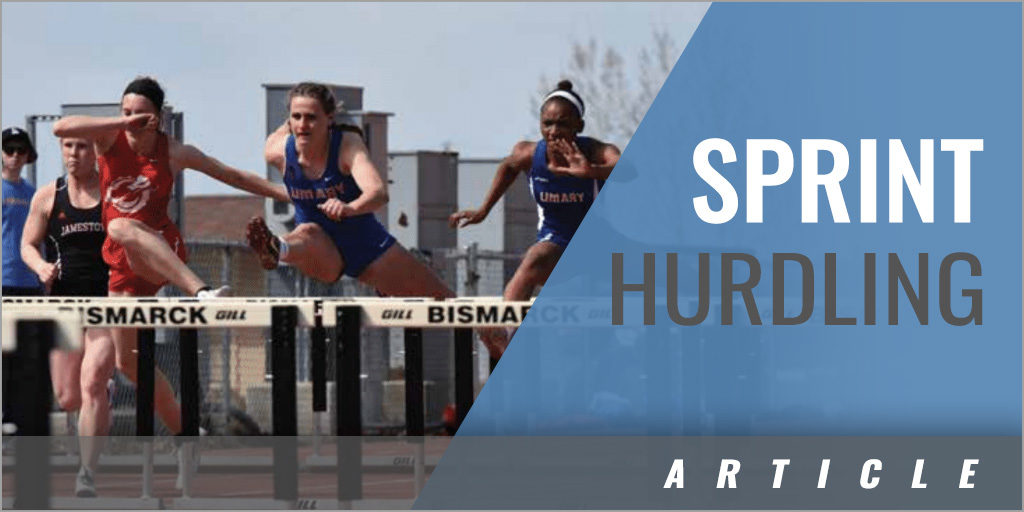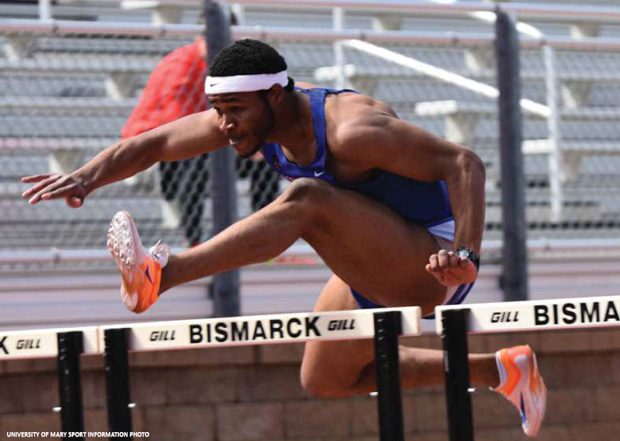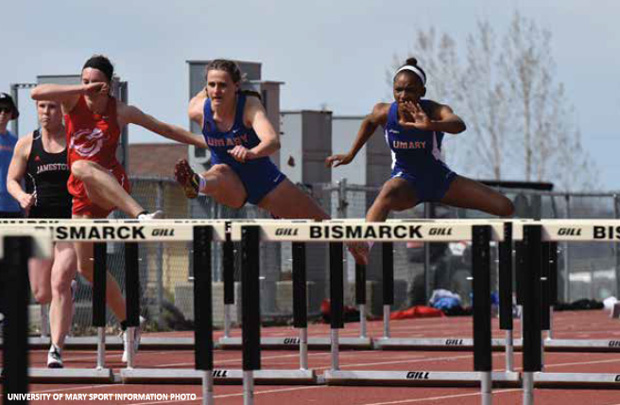|
By: Mike Thorson - University of Mary Originally Published in: Techniques Magazine Provided by: USTFCCCA
The short hurdle races (100m Hurdles for Women and 110m Hurdles for men) are a rhythmic sprint over 10 equally spaced barriers that require speed, power and technical efficiency. The women's 100m Hurdle race consists of 10 hurdles set at 33" in height. The distance to the first hurdle is 13m and the distance between 8.5m, with a run-in after the last hurdle of 10.5m. The men's 110m Hurdles consists of 10 hurdles set at 42" and the distance to the first hurdle is 13.72m (45 feet). The distance between hurdles is 9.14m (30 feet), with the run-in distance 14.02m. This article will attempt to provide coaches with a concise, practical, user-friendly guide to training at a higher level and ultimately performing better in the sprint hurdles. Our goal is to present the technical aspects and necessary training in a comprehensive, yet practical application that all coaches and athletes can employ to improve their performances. HURDLING 101 Start and Approach to the first hurdle
LEAD LEG
HURDLE CLEARANCE
TRAIL LEG
TRAIL ARM
DIFFERENCES BETWEEN MEN AND WOMEN It is a serious mistake to treat the men's and women's hurdles the same. They are vastly different. Speed is the most important component of the women's hurdles. Although it is also very important for men, technique is just as important in producing quality times. Many of the top women's hurdlers are not technically sound. Some are actually quite poor but excel due to their speed and the lower hurdle heights. Men don't have that luxury. Men must maintain a much higher center of gravity, the lean is much more pronounced, and the trail leg brought through much higher, through the armpit, to name just a few of the obvious technical differences between men and women. The very best men's hurdlers certainly have great speed, but they must be very good technically as well. TRAINING GUIDELINES/PRINCIPLES"HOW TO GET FASTER"
MARAUDER HURDLE DRILLS: DRILLS THAT WORK; DRILLS THAT PRODUCE RESULTS Lead Leg-Trail Leg Drill Any number of hurdles set at very short spacing with drills done on the side of the hurdles at low heights. Athletes rehearse the lead and trail leg mechanics at different speeds ranging from walking to running at 75-80%. The drill can be done walking, marching, skipping or running. Another version of the lead leg-trail leg drill is to march through the hurdles with even shorter distances employing fast feet and fast arms, with an emphasis on the arm speed. The drill can be done with spikes, but preferably flats.
Arm Drills Any number of lower hurdles (30" or lower for women; 36" for men) can be used for this drill at reduced, discounted spacing (28 feet for men and 7.0 meters for women, although spacing is not critically important because the drill is done at slower controlled speeds). The drill is misnamed in that the athlete must hurdle at slower speeds (75-80%) without using the arms. There are three versions:
Coaching cues: Emphasize leading with the knee, squaring up hips and shoulders to the hurdles, and letting the body balance itself without the use of the arms. It is a great drill to teach body awareness and balance to eliminate rotational problems. The arm drills are typically done in flats. One Step Hurdles From a standing start on the start line, hurdle any amount of hurdles spaced so that the hurdler has only 1 step to clear the hurdle. The 1st hurdle can be on the mark and others spaced at low heights 12-13 back-to-back steps for both men and women. The drill teaches athletes to lead with the knee, flexed lead leg, projecting hips through the hurdle and getting down very quickly with an active trail leg. It is also useful to eliminate a "swinging" of the lead leg. The drill should be done in spikes at controlled speeds, with an emphasis on arm speed and projecting hips through the hurdle. Tempo Hurdles Set(s) of any number of hurdles done in spikes with regular hurdle form with close to all out intensity. Shuttle Hurdles Athlete hurdles one lane of barriers in one direction and turns around and returns in another lane of hurdles, doing a series of loops/reps. The hurdles can be set at any height, although lower heights would typically be used as less energy and force is required for the lower heights in a drill that can be very demanding. The drill should be done in spikes with sets of different recovery times, depending on the objective. It is obviously a great drill for the intermediate hurdler in terms of teaching alternating legs, making adjustments (steering) and simulating the demands of the 400 hurdle race in terms of fatigue/energy systems. It teaches the athlete to hurdle in a fatigued state. Lead Leg/Trail Leg Wall Attack Drill With a low hurdle against wall, fall forward into wall and attack with the lead leg, stressing a flexed lead leg with a cocked foot and leading with the knee. The opposite arm also drives into the wall. Another version of this drill is to take one step and then fall forward into wall. The hurdle can be moved out too and trail legs can be done on the side of the hurdle. Another version is to place hands on wall and go back and forth in a stationary position alternating the trail leg movement over the top of the hurdle. The drill should be done in flats. Race Endurance Simulation Drill Repeat hurdle reps from blocks with spikes using dis-counted hurdles and spacing and very little recovery. The hurdler jogs back and goes immediately from blocks again. The recommendation is to use 6-7 hurdles. A break-down in speed and mechanics on the second rep will indicate too many hurdles are being used. The drill is used to train speed maintenance in the closing stages of the race. SPEED/SPEED ENDURANCE There are those that argue that the short hurdles are not a sprint event. Be that as it may, one cannot argue that it is not a speed event. Nearly all elite men's and women's hurdlers take the same number of strides in a race (51). So it is reasonable to assume that the hurdler with the greatest stride frequency should have the most success, providing power and technical efficiency are equal to the other competitors. Speed endurance needs to be a component of all sprint hurdlers. Many hurdlers who perform very well indoors are very substandard when the additional barriers are added outdoors and the speed endurance ingredient is lacking. Different combinations of hurdles and recovery time can certainly increase speed maintenance. But short hurdlers will need the different types of speed endurance training to be an elite hurdler and maintain the desired speeds over hurdles 6-10. The short hurdler needs to be able to run a very quality 200/300m to be an elite 100/110m hurdler! A brief explanation of the training that a sprint hurdler should utilize: SPEED Runs of 95-100% intensity over 30-60 meters or up to six seconds of running. Example: 4 x 40m Blasts with spikes from blocks @ 100% intensity with 5-6 minutes recovery per rep. SPEED ENDURANCE Runs of 95-100% of maximum over 60-150m or 7-20 seconds of running. Example: 3 x 80m @ 95-100% from 4-point stance with 4-5 minutes rest, 10 minutes recovery followed by SPEED ENDURANCE 1 Runs of 95-100% of maximum over 150-300m or 20-40 seconds of running. Example: 2 x 150m with spikes @ 95% intensity with 6 minutes recovery, 10 minutes recovery between set, 1 x 200m with spikes @ 95-100% intensity. SPEED ENDURANCE 2 Runs of 95-100% of maximum over 300-600m or 40 seconds of running or over. Example: STRENGTH, WARMUP, SUPPLENESS STRENGTH Without getting into specifics, the strength program chosen should emphasize functional strength: sport-specific strength that the athlete can actually use. Most authorities will agree that medium loads with a fast series of repetitions are typically what most hurdlers/sprinters need. There will be a need too for some heavy loads to train the power that is needed in the acceleration phase. If you are a coach that does not set up the training programs for your athletes, constant, daily communication with the strength coach is essential. WARMUP There are many types of warmup programs that can be utilized. Most coaches acknowledge that a dynamic, continuous warmup is most suited for high performance training and competition. Regardless of what type of warmup is used, it must train flexibility, power, sprint mechanics, balance and strength in addition to serving to prepare the body for performance and prevent injury. Time must be devoted to mobility and assuring that the hurdler is very supple. The extreme range of motion that is required for an elite hurdler must be trained. The warmup should really be looked upon as a speed improvement tool in itself. SAMPLE OFF SEASON TRAINING WEEK Monday: am-Hurdle Technique pm- Speed Endurance 2 Interval Training, Strength Training Tuesday: Recovery - (Circuit Training, Speed Circuits, Med Ball Training, Elliptical, Stationary Bike) Wednesday: am-Hurdle Technique pm-Speed Endurance 1 Interval Training, Strength Training Thursday: Recovery - (Circuit Training, Friday: Hill work or Speed Endurance Saturday: Rest Sunday: 20 minutes Light on Elliptical or Stationary Bike ACTUAL TRAINING WEEK - JOSH LAMERS WEEK 31 APRIL 9-15 Note: Actual Training week for Josh Lamers, who ran 13.85 to place second in the 110m Hurdles at the 2018 NCAA Division II Outdoor Championships Monday, April 9 - Hurdle Technique fol-lowed by 1 x 250m w/spikes @ 95-98%, 12 minutes Recovery, 1 x 200m w/spikes @ 95-98%, Strength Training Tuesday, April 10 - Stationary Bike 15 minutes, Warmup, Accels w/spikes, Orange Med Ball Circuit (15 Throws) Wednesday, April 11 - Hurdle Technique followed by 3 x 150m w/spikes @ 95% 6 minutes Recovery, Strength Training Thursday, April 12 - Warmup, Recovery Circuit, Accels w/spikes Friday, April 13 - Pre Meet Hurdle Technique Warmup Saturday, April 14 - Meet @ NDSU in Fargo ND Sunday, April 15 - 20 minutes Elliptical (Recovery) ACTUAL MEN'S 110M HURDLE TECHNIQUE TRAINING SESSION Monday, March 12 (Outdoors) Marauder Warmup Walking Arms 2 x 10m Walking Lunge Backwards 2 x 10m Accels 4 in flats 1 Step Hurdles 5 Hurdles x 3 @ 36 inches 1 x Flying 20 on turn (Time) 40m Blast From Blocks (Time) Tempo Hurdles 6 Hurdles x 2 @ 39" (From a 4-point start) 4 Hurdles From Blocks with hand weights @ 39" x 1 4 Hurdles From Blocks x 1 @ 36" 7 Hurdles From Blocks x 2 @ 42" for the first hurdle and 39" for following 6 hurdles (Time) 6 Hurdles from Blocks x 1 @ 42" for the first hurdle and 39" for the following 6 hurdles (Time) 15 minutes Stationary Bike (Recovery) NOTE: Spikes for 5-12 ACTUAL WOMEN'S 100M HURDLE TECHNIQUE SESSION Tuesday, March 20 Marauder Warmup Sitting Stationary Arms 2 x 20 seconds Cone Hops (Big - 12 inch cone) with Eyes Closed 2 X 20 seconds Accels 4 in spikes (Spikes worn through the remainder of the session) Lead Leg-Trail Leg Drill 3 Hurdles 2 on each leg Arm Drill 3 Hurdles x 2 with the Arms to the Chest 1 x 30m Fly on turn (Time) 1 x 30m From Blocks (Time) Tempo Hurdles 4 Hurdles x 3 @ 30" From a 4-point start 3 Hurdles From Blocks x 2 with hand weights 33"- 30"- 30" 1 x Flying 20 on straight (Time) 7 Hurdles From Blocks x 1 33" for first hurdle followed by 30" (Time) 3 Hurdles From Blocks with hand weights x 1 @ 33"-30"-30" 6 Hurdles From Blocks x 2 @ 30" (Time) Warmdown - Jogging barefoot followed by foam roll and 10-15 minutes Stationary Bike REFERENCES
MIKE THORSON IS AN ASSISTANT COACH (HURDLES) AT THE UNIVERSITY OF MARY. HE IS THE FORMER DIRECTOR OF TRACK & FIELD/CROSS COUNTRY AT THE UNIVERSITY OF MARY |









